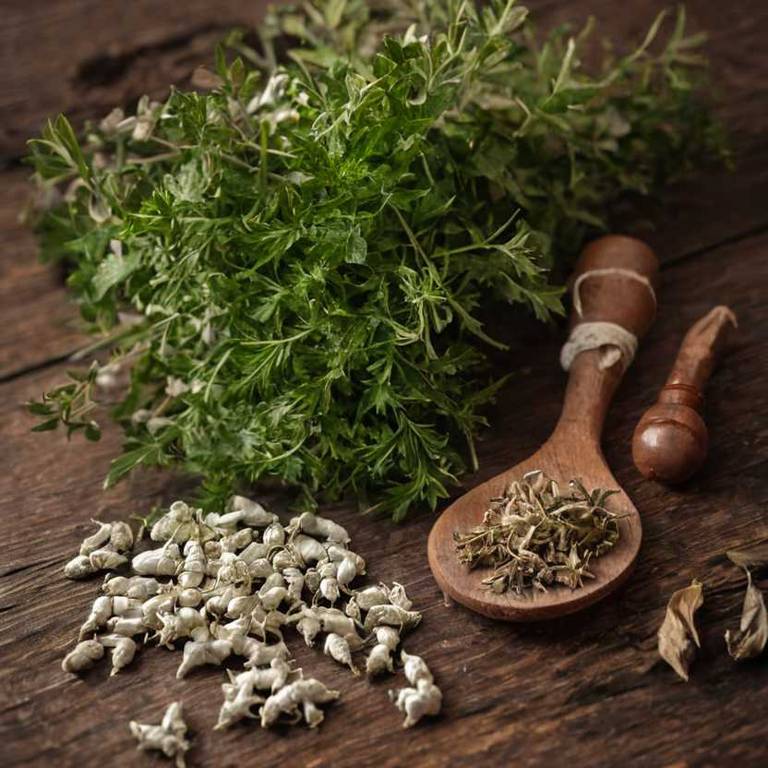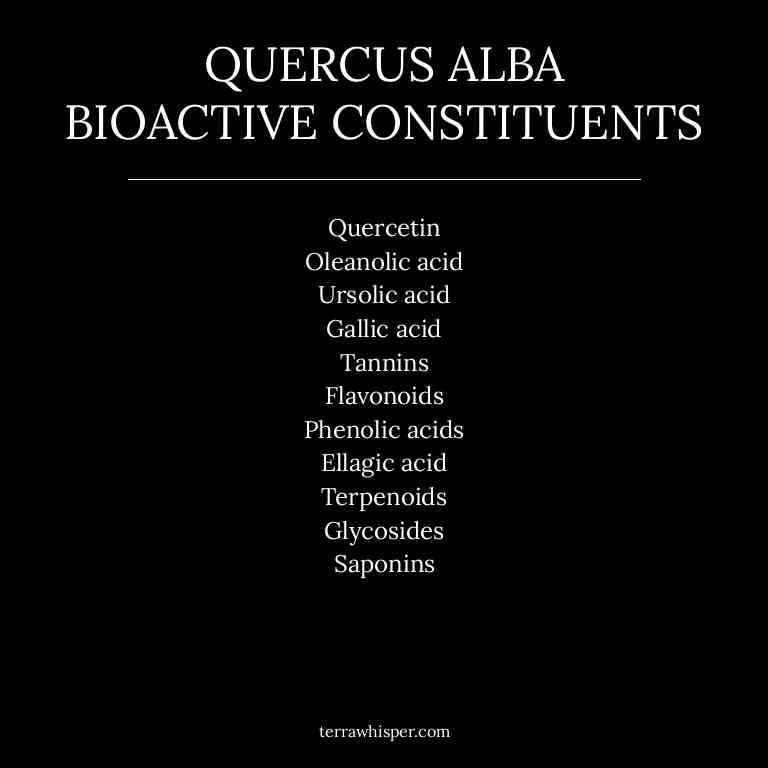Quercus Alba Uses, Benefits, And Remedies

Quercus alba, commonly known as the white oak, is a deciduous tree native to North America, whose leaves and bark have been used in traditional herbal medicine.
This herb is valued for its astringent properties and is used to support digestive health, reduce inflammation, and promote wound healing.
The bioactive constituents in Quercus alba include tannins, flavonoids, and quercetin, which contribute to its antioxidant, anti-inflammatory, and antimicrobial effects.
Herbal preparations such as infusions, tinctures, and decoctions can be made from the leaves and bark to harness its therapeutic benefits.
This page analize the most important medicinal aspects of Quercus alba.
Health Benefits
Quercus alba reduces oxidation due to its high concentration of antioxidants, such as quercetin, which neutralize free radicals and prevent cellular damage by donating electrons to unstable molecules.
It eases inflammation by inhibiting the production of pro-inflammatory cytokines and reducing the activity of enzymes like cyclooxygenase, which are involved in the inflammatory response. It relieves pain by modulating pain signaling pathways and reducing the release of inflammatory mediators that contribute to pain perception. It fights infections by enhancing the immune system's ability to combat pathogens through its antimicrobial and antiviral properties.
It prevents heart disease by improving endothelial function, reducing oxidative stress, and lowering blood pressure, thereby supporting cardiovascular health.
The 10 best health benefits of Quercus alba are shown in the image below.

The list below give a brief description of the 10 best health benefits of Quercus alba.
- Reduces Oxidation: Quercus alba herb contains antioxidants that help neutralize free radicals, reducing oxidative stress in the body.
- Eases Inflammation: The anti-inflammatory properties of Quercus alba can help reduce swelling and irritation in the body.
- Relieves Pain: Quercus alba has natural pain-relieving properties that can help alleviate various types of discomfort.
- Fights Infections: The herb exhibits antimicrobial properties that can help combat bacterial and viral infections.
- Prevents Heart: Quercus alba may support cardiovascular health by improving blood flow and reducing cholesterol levels.
- Supports Bones: The herb contains compounds that may promote bone health and strengthen the skeletal system.
- Reduces Arthritis: Quercus alba can help reduce joint inflammation and pain associated with arthritis conditions.
The 11 best bioactive constituents of Quercus alba are shown in the image below.

The list below give a brief description of the 10 best bioactive constituents of Quercus alba.
- Quercetin: A flavonoid with strong antioxidant properties, known for its anti-inflammatory, antiviral, and antitumor effects.
- Oleanolic Acid: A triterpene with anti-inflammatory, antiviral, and antitumor properties, also showing hepatoprotective effects.
- Ursolic Acid: A pentacyclic triterpene with anti-inflammatory, antimicrobial, and anti-cancer properties, also aiding in skin health.
- Gallic Acid: A phenolic acid with potent antioxidant and anti-inflammatory properties, known for its antimicrobial and antiviral effects.
- Tannins: Polyphenolic compounds with astringent properties, known for their antioxidant, antimicrobial, and anti-inflammatory effects.
- Flavonoids: A group of phytochemicals with antioxidant, anti-inflammatory, and antiviral properties, contributing to overall health benefits.
- Phenolic Acids: Compounds with antioxidant properties that help neutralize free radicals, reduce inflammation, and protect cells from damage.
- Ellagic Acid: A polyphenol with antioxidant, anti-inflammatory, and anti-cancer properties, also showing antimicrobial effects.
- Terpenoids: A diverse class of organic compounds with various biological activities, including antioxidant, anti-inflammatory, and antimicrobial properties.
- Glycosides: Compounds composed of a sugar and a non-sugar component, often with medicinal properties such as antioxidant and anti-inflammatory effects.
- Saponins: Natural compounds with surfactant properties, known for their antioxidant, anti-inflammatory, and antimicrobial effects.
Medicinal Parts
Quercus alba leaf has been traditionally used in herbal medicine for its rich content of tannins, flavonoids, and other bioactive compounds that contribute to its medicinal properties.
The leaves are commonly harvested during the summer months and are often used to make teas or extracts that can help reduce inflammation and soothe digestive issues. They are also known for their astringent qualities, which can be beneficial in treating skin conditions and reducing bleeding. In traditional medicine, the leaves have been used to treat ailments such as diarrhea, fever, and respiratory infections due to their antimicrobial and antioxidant effects.
Additionally, the leaves may support immune function and have potential applications in managing diabetes due to their hypoglycemic properties.
Herbal Preparations
Quercus alba teas are a popular method of consuming the white oak herb, often prepared by steeping dried leaves in hot water to extract its beneficial compounds.
These teas are valued for their astringent properties and are commonly used to support digestive health and reduce inflammation. Decoctions, which involve boiling the leaves for a longer period, are another preparation method that enhances the extraction of tannins and other active constituents. Tinctures made from Quercus alba are also widely used, as they provide a concentrated form of the herb that can be easily absorbed into the bloodstream.
In addition to teas and tinctures, the herb is also used in creams and ointments to soothe skin irritations and promote wound healing. Its mucilage content makes it useful in syrups and lozenges for alleviating sore throats and respiratory issues. Liniments and oils infused with Quercus alba are applied topically to relieve muscle pain and joint discomfort. Poultices made from the leaves can be used to treat minor infections and reduce swelling.
The versatility of Quercus alba allows it to be incorporated into various herbal preparations, making it a valuable component in traditional and modern herbal medicine.
The 10 best herbal preparations of Quercus alba are shown in the image below.

The list below give a brief description of the 10 best herbal preparations of Quercus alba.
- Teas: Used to support respiratory health, reduce inflammation, and alleviate symptoms of colds and sore throats due to its antioxidant and anti-inflammatory properties.
- Decoctions: Employed for digestive support and to treat gastrointestinal issues, as decoctions can extract more complex compounds from the herb.
- Tinctures: Used for their concentrated form of active compounds, tinctures are often taken internally to support immune function and reduce inflammation.
- Creams: Applied topically to soothe skin irritations, reduce inflammation, and promote healing of minor wounds and rashes.
- Syrups: Used to relieve coughs and sore throats, syrups provide a palatable form of the herb for children and adults alike.
- Mucillages: Known for their ability to soothe and protect mucous membranes, mucillages are used to treat digestive tract discomfort and respiratory issues.
- Capsules: Offer a convenient and standardized form of the herb for daily use, supporting immune function and general wellness.
- Oinments: Applied externally to treat skin conditions, reduce inflammation, and provide relief from muscle aches and joint pain.
- Juices: Used for their high concentration of nutrients and antioxidants, juices can support detoxification and overall vitality.
- Lozenges: Designed to soothe sore throats and reduce coughing, lozenges provide targeted relief for respiratory discomfort.
Side Effects of quercus alba
Quercus alba can trigger allergic reactions due to the presence of allergenic proteins and pollen in the plant, which can be inhaled or come into contact with the skin, leading to immune system responses.
Quercus alba results in eye irritation because its pollen and fine particles can become airborne and settle on the eyes, causing redness, itching, and excessive tearing. Quercus alba can lead to itching as a result of skin contact with its sap or pollen, which may contain irritants that stimulate nerve endings and trigger histamine release.
Quercus alba causes skin irritation due to the presence of compounds like tannins and other irritants in its sap, which can provoke inflammation and redness upon direct contact.
The 11 most common side effects of Quercus alba are shown in the image below.

The list below give a brief description of the 11 most common side effects of Quercus alba.
- Can Trigger Allergic Reactions: Individuals with allergies may experience symptoms such as hives, swelling, or difficulty breathing upon exposure to Quercus alba.
- Results In Eye Irritation: Contact with the herb may cause redness, burning, or watering of the eyes.
- Can Lead To Itching: Skin contact with Quercus alba may result in an itchy rash or irritation.
- Causes Skin Irritation: Direct contact with the herb can lead to redness, dryness, or a burning sensation on the skin.
- Leads To Throat Irritation: Inhaling particles of Quercus alba may cause a sore or scratchy throat.
- Causes Skin Rashes: Exposure to the herb may result in the development of skin rashes or bumps.
- Results In Sneezing: Inhalation of Quercus alba particles may trigger sneezing in sensitive individuals.
- Can Induce Skin Redness: Contact with the herb may cause the skin to become red or inflamed.
- Causes Eye Redness: Prolonged exposure to Quercus alba may lead to redness and discomfort in the eyes.
- Leads To Stomach Upset: Consuming Quercus alba may cause nausea, cramping, or digestive discomfort.
- May Cause Nausea: Ingestion of Quercus alba can lead to feelings of sickness or an upset stomach.